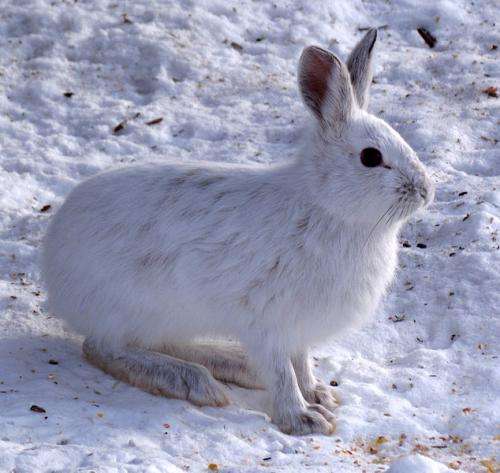April 16, 2013 report
Study finds change in snow cover patterns making snowshoe hare more vulnerable

(Phys.org) —A team of researchers in the United States has found evidence to suggest that global warming may be making snowshoe hare's more vulnerable to prey as the cycle of snow cover change in their environment leaves them with the wrong color coat at times. In their paper published in the Proceedings of the National Academy of Sciences, the group details how they compared molting times of snowshoe hares with the time and duration of snow cover and found enough overlap to indicate the hares appear to heading towards vulnerability.
Snowshoe hares sport fur of different colors depending on the season. Ideally, they are all white when the ground is covered with snow and a mix of browns when the snow has all melted. This, of course, allows them to blend in with their surroundings making it difficult for predators to see them. The results of this new research effort indicate that the crossover time—when the hares molt, shedding their white fur to replace it with brown—no longer correlates evenly with times of snow cover. This, they say, appears to be due to global warming.
Until this study, it hasn't been clear whether molting times for snowshoe hares was connected with the weather, or if it occurred at roughly the same time every year regardless of snow cover. To find out, and to see if snowshoe hares might be in trouble, the researchers captured and put radio tags on 50 of the animals over the course of three winters. The tags allowed the researchers to track down the hares to note the degree of molting that had occurred at certain times. They compared that information with data about the weather—temperature and degree of snow cover in the area where the hares lived.
The researchers found that the hares aren't able to adjust their molting time—they start losing their fur and growing in the new color on or around the same date every year—October 10th in the fall, and April 10th again in the spring. Until recently, those dates coincided very closely with the onset or loss of snow cover. Over the years studied, the researchers found widely varying levels of snowpack, which resulted in the hares oftentimes displaying mostly white fur during times when there was no snow on the ground, making them highly visible to predators. They suggest that unless the hares learn to adapt rather quickly, they will likely find it much more difficult to survive in a new warmer world.
More information: Camouflage mismatch in seasonal coat color due to decreased snow duration, PNAS, Published online before print April 15, 2013, doi: 10.1073/pnas.1222724110
Abstract
Most examples of seasonal mismatches in phenology span multiple trophic levels, with timing of animal reproduction, hibernation, or migration becoming detached from peak food supply. The consequences of such mismatches are difficult to link to specific future climate change scenarios because the responses across trophic levels have complex underlying climate drivers often confounded by other stressors. In contrast, seasonal coat color polyphenism creating camouflage against snow is a direct and potentially severe type of seasonal mismatch if crypsis becomes compromised by the animal being white when snow is absent. It is unknown whether plasticity in the initiation or rate of coat color change will be able to reduce mismatch between the seasonal coat color and an increasingly snow-free background. We find that natural populations of snowshoe hares exposed to 3 y of widely varying snowpack have plasticity in the rate of the spring white-to-brown molt, but not in either the initiation dates of color change or the rate of the fall brown-to-white molt. Using an ensemble of locally downscaled climate projections, we also show that annual average duration of snowpack is forecast to decrease by 29–35 d by midcentury and 40–69 d by the end of the century. Without evolution in coat color phenology, the reduced snow duration will increase the number of days that white hares will be mismatched on a snowless background by four- to eightfold by the end of the century. This novel and visually compelling climate change-induced stressor likely applies to >9 widely distributed mammals with seasonal coat color.
Journal information: Proceedings of the National Academy of Sciences
© 2013 Phys.org















